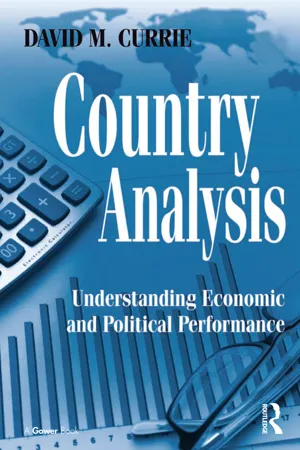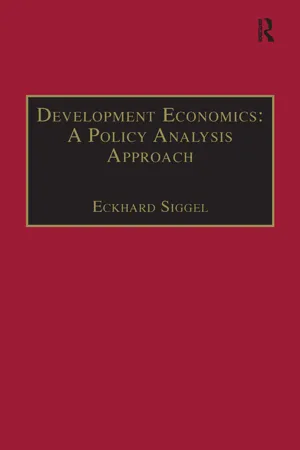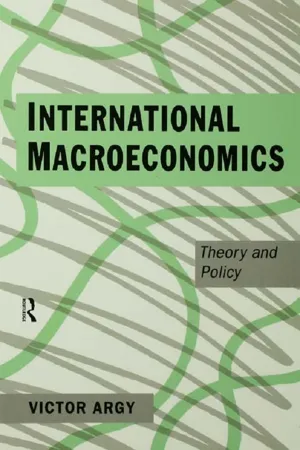Economics
Long Run Exchange Rate
The long run exchange rate refers to the equilibrium value at which the supply and demand for a currency balance out over an extended period. It is influenced by factors such as inflation rates, interest rates, and economic growth. In the long run, exchange rates tend to reflect the relative purchasing power of different currencies.
Written by Perlego with AI-assistance
Related key terms
7 Key excerpts on "Long Run Exchange Rate"
- eBook - ePub
- Enrico Colombatto(Author)
- 2016(Publication Date)
- Routledge(Publisher)
Of course, exchange rates are not only a convenient way of registering transactions and enhancing accounting practices. Exchange rates are also important because operators must buy and sell foreign currencies in order to pay for foreign goods or to obtain the domestic monetary units with which to buy domestic inputs. The exchange rate, therefore, is also the rate at which individuals buy/sell currencies with a view to expanding the range of their economic transactions.The study of the variables that affect the dynamics of currency markets is the core of exchange-rate economics, which usually follows different lines of reasoning depending on the regime adopted by a country or group of countries. By and large, the nature and degree of government intervention give origin to five different exchange-rate regimes: the gold standard (sections 9.2–9.5), flexible-exchange rates (sections 9.6–9.10), fixed-exchange rates (section 9.11), currency boards (section 9.12) and monetary unions (section 9.13). For each regime, this chapter illustrates the underlying working assumptions, some of the consequences the various regimes generate with regard to the domestic economy, the extent to which government commitments are credible, and the variables that affect adjustment.9.2 Simple exchange rate economics: the gold standard
When the monetary system is based on a real standard (e.g., the gold standard), the determination of the exchange rate is straightforward. As we noted in Chapter 7 (section 7.2), each monetary unit (the dollar, the pound or the franc) designates a given quantity of gold. This is known as the gold parity. Since gold is gold regardless of the jurisdiction from which it comes, and independent of how one calls the (gold) coins minted in that jurisdiction, under a gold standard the exchange rate between two currencies is necessarily the ratio between the two gold parities. If 1.5 grams of gold are called one dollar in the USA, and 0.20 pounds in Britain, the dollar/pound exchange rate is inevitably 5 dollars per pound (1/0.20). Put differently, you need the amount of gold ‘contained’ in five US dollars in order to match the amount of gold ‘contained’ in one British pound. - eBook - ePub
- W. Charles Sawyer, Richard L. Sprinkle(Authors)
- 2020(Publication Date)
- Routledge(Publisher)
CHAPTER 14Exchange rates and their determinationA basic modelThe exchange rate is determined from day to day by supply and demand of home currency in terms of foreign currency. Each transaction is two-sided, and sales are equal to purchases. Any change in the conditions of demand or of supply reflects itself in a change in the exchange rate, and at the ruling rate the balance of payments balances from day to day, or from moment to moment.Joan RobinsonINTRODUCTIONT he international value of a country’s currency has become an inescapable part of the daily flow of economic information. Most of us are aware that a country’s exchange rate is important, but many of us do not have a clear idea of why the exchange rate matters or what causes it to change. As the chapter’s opening quote indicates, the familiar tools of supply and demand analysis can be used to determine a country’s exchange rate. In this chapter, you will learn why the supply and demand model works in analyzing exchange rates—in the same manner, in fact, that it works in analyzing the price of gasoline or pizza, for one dollar or one yen or one gallon of gasoline is indistinguishable from another. By the end of this chapter you should have a good grasp of why exchange rates are important and what factors cause them to change over the long run. Finally, it is obvious to even a casual observer that exchange rates change frequently. These changes, or volatility, are a source of aggravation for individuals, businesses, and governments. The chapter explains what economists know about the effects of exchange rate volatility on international trade and how changes in exchange rates affect the prices of the goods and services we purchase. The final part of the chapter deals with the underlying value of a currency. While the exchange rate we observe in the market often differs from that value, it is very useful to know what that value is.EXCHANGE RATESSuppose that a U.S. importer is purchasing British Jaguars. To purchase the Jaguars, the importer needs to obtain British pounds by exchanging dollars for pounds. The demand for foreign currency is derived from individuals demanding foreign goods and services. This relationship can be applied in reverse. As individuals in the U.K. demand U.S. products, there is an increased demand for dollars. However, this raises the question of how many dollars must be exchanged to obtain the requisite number of pounds, or vice versa? In this example, the relevant exchange rate is the U.S. dollar–U.K. pound exchange rate. In general, the exchange rate is the price of one country’s currency in terms of another. The demand for British pounds relative to the supply of pounds will determine the exchange rate, just as the demand for gasoline relative to the supply of gasoline determines the price of gasoline. Exchange rates fluctuate considerably over time. However, unlike the price of gasoline, changes in the exchange rate are expressed as changes in the value of the domestic country’s currency. An increase in the value of a currency is referred to as appreciation. Analogously, a decline in the value of the currency is referred to as depreciation - eBook - ePub
Country Analysis
Understanding Economic and Political Performance
- David M. Currie(Author)
- 2016(Publication Date)
- Routledge(Publisher)
explain the factors that influence the value of a currency; 6. explain the difference between fixed and floating exchange rate regimes; 7. explain the risk in a currency transaction caused by appreciation or depreciation of either currency. What is an Exchange Rate? An exchange rate is simply a price that tells you how much a currency is worth in terms of another currency. Because this book is intended for a US audience, most of the discussion will be in terms of how much a US dollar is worth, but the same reasoning applies to any other currency: how much a UK pound is worth in terms of euros, or how much a euro is worth in terms of Japanese yen. Any currency can be stated relative to another currency, and the price is its exchange rate. The exchange rate can be established in two ways: by the government of a country, or by the international currency market. In the old days, before the Second World War, governments set exchange rates that initially were based on the gold content of each country’s coins. When that system ran into complications, rates were set by agreements between governments in what was known as the Bretton Woods system. When the Bretton Woods system failed in the 1970s, most governments left it to markets to determine exchange rates. With a few notable exceptions, today most exchange rates are determined on the currency market. When a government sets an exchange rate and attempts to maintain that value, it is called a fixed exchange rate regime. When governments give up the effort and allow markets to determine exchange rates, it is called a floating exchange rate regime. Between the two extremes are several variations, but those are the choices facing any government: the government can attempt to dictate the exchange rate, or it can leave the decision up to the market - Eckhard Siggel(Author)
- 2016(Publication Date)
- Routledge(Publisher)
The main advantage of maintaining a fixed rate is to avoid rate fluctuations and the uncertainty they entail for traders. Fixed rates are also used as an anchor to keep inflation rates low. An international monetary regime based on fixed rates was advocated by the Bretton Woods conference in 1944 and became the rule after the Second World War. This regime was a gold-exchange standard, which relied on the stability of and the confidence in the main reserve currency, the U.S.$. In the late 1960s and early 1970s it came increasingly under fire, due to increasing budget and external deficits of the U.S., as well as rapidly increasing international needs for reserve currency, but limited gold stocks. Many authors then considered flexible regimes to be more in line with modern growth and liberal trade policy. Between 1971 and 1973 the regime was abandoned by the main trading nations and replaced by a flexible rate regime. Today we find cases of both fixed and flexible rates, with most currencies in intermediate positions, that is, of limited degrees of flexibility. In some countries fixed and semi-fixed rates are pegged either against a major international currencies like the U.S. dollar, or against baskets of currencies reflecting the particular trade relationships of a country, or against the Special Drawing Rights (SDR), regarded as the currency of the International Monetary Fund (IMF). A particularly interesting case is the currency of the European Union, the Euro, the case of a monetary union, which is equivalent of a rigidly fixed exchange rate. Vis-à-vis the U.S.$ and other currencies, however, the Euro is flexible. Even before the introduction of the Euro in 1999, the currencies of the European Union members were in a fixed relationship known as the European Monetary System (EMS).The exchange rate is a price and it is usually expressed as the domestic price of foreign currency, with the dimension of domestic currency units (dcu) per foreign currency unit (feu). A second way of expressing it is as the foreign currency price of the domestic currency (fcu/dcu). The former definition is more widely used by economists than the latter, because it makes it convenient to treat the exchange rate as the price of a productive factor, foreign exchange. It is probably the single most important price in the economy, due to its pervasive influence on most sectors of the economy. While a perfectly flexible rate can be expected to be an equilibrium rate, pegged rates are more likely to be misaligned. What exactly is meant by misalignment depends on the perspective. Generally, we say that an exchange rate is well aligned if it leads to external equilibrium. In a long-run perspective it should also reflect the true purchasing power of the currency. There are various ways of calculating the degree of misalignment of an exchange rate. The more traditional way is to estimate a shadow or general equilibrium rate and to compare it with the going rate. If the going rate is clearly inferior to the equilibrium rate (defined as the price of foreign currency), we say that the domestic currency is over-valued. A more modern approach is to compute the real exchange rate and to use it for inference about over- or undervaluation. This is demonstrated in more detail in the later section 6.4- eBook - ePub
Economics for Investment Decision Makers
Micro, Macro, and International Economics
- Christopher D. Piros, Jerald E. Pinto(Authors)
- 2013(Publication Date)
- Wiley(Publisher)
To rectify that problem, Dornbusch (1976) constructed a modified monetary model of the exchange rate that assumes output prices exhibit limited flexibility in the short run but are fully flexible in the long run. The long-run flexibility of the price level ensures that any increase in the domestic money supply will give rise to a proportional increase in domestic prices and thus contribute to a depreciation of the domestic currency in the long run, which is consistent with the pure monetary model. If the domestic price level is assumed to be inflexible in the short run, however, the model implies that the exchange rate is likely to overshoot its long-run PPP path in the short run. With inflexible domestic prices in the short run, any increase in the nominal money supply results in an identical increase in the real money supply over the relevant short-term period, which in turn induces a decline in the domestic interest rate. Assuming capital is highly mobile, the decline in domestic interest rates will precipitate a capital outflow, which will cause the exchange rate to overshoot its new long-run equilibrium level to the downside on a short-run basis. Hence, in the short run, the domestic currency depreciates in both real and nominal terms. In the long run, once domestic prices rise and domestic interest rates rise in tandem, the exchange rate will recover from its overshoot level and move into line with the path predicted by the conventional monetary approach described in Section 6.2.1. The nominal exchange rate converges back to the path dictated by PPP as the domestic price level gradually adjusts and the real exchange rate returns to the equilibrium level.6.3. The Taylor Rule and the Determination of Exchange Rates
The Mundell–Fleming and monetary models of exchange rates assume that a central bank targets, and can directly control, a country’s money supply or its growth rate. Today, however, many major central banks tend to conduct policy via interest rate targets, not money supply targets. Although this practice does not invalidate the insights we have gleaned from the previous models, it is useful to consider the implications of combining a well-known interest rate targeting framework—the Taylor rule—with a basic exchange rate model. - eBook - ePub
- Dan Richards, Manzur Rashid, Peter Antonioni(Authors)
- 2016(Publication Date)
- For Dummies(Publisher)
Part 3The Long-Run Macro Economy
IN THIS PART … Understand the importance of economic growth and the determination of the economy’s long-run growth path. Discover that in the long run, inflation is determined by money growth. Discover that in the long run, real interest rates primarily reflect households’ willingness to save.Passage contains an image Chapter 8
GDP Growth in the Long Run
IN THIS CHAPTER Compounding growth: The rule of 70 Marginalizing firm decisions Growing GDP over time Steadying the stateWe’ve said it before and we’ll say it again: Economists love models. Building an economic model and considering its implications forces you to think hard about which assumptions lead to which results and whether those assumptions make sense. And it’s only after you have a model that you can begin to test it with evidence.Some of the time, or maybe most of the time, economists disagree at one or more of these stages. They argue over assumptions. They argue over the empirical evidence. They argue over arguing. But in macroeconomics, one area where economists don’t argue too much is about the nature of the long run. There is a lot of agreement about the economy’s long-run behavior and which macroeconomic policies will promote a healthy long-run growth path.That long-run path is an anchor — a full equilibrium. It is in fact the potential output described in Chapter 3 , because it reflects full employment of the economy’s capital and labor resources. Whatever happens in the short run, there are forces (sometimes weak but always present) that pull the economy back toward that potential. Put somewhat differently, recessions can cause the economy to drift away from its long-run equilibrium for some time and by a significant amount. But ultimately the economy always returns to that long run, full-employment path.In this chapter, you’ll hear about the long-run growth model that most macroeconomists think works for modern economies like the U.S. You’ll also get an idea of the critical but complicated role that society’s willingness to save plays in that model — and what the long-run equilibrium says about interest rates and the price of credit as well. - eBook - ePub
International Macroeconomics
Theory and Policy
- Victor Argy(Author)
- 2013(Publication Date)
- Routledge(Publisher)
reinforces exchange rate trends, pulling the exchange rate away from equilibrium over extended periods.Fourth, one of the themes of this book is that the longer-run effects of policy changes (i.e. after wages-prices have fully adjusted and wealth effects are accounted for) are often dramatically different from short-run effects. Often the ultimate direction of change in the real exchange rate is the reverse of that in the short run (see Chapters 20 and 30 ). This again introduces an element of inherent instability in the exchange rate, notably in response to a sustained disturbance.Fifth, wage indexation creates the potential for generating vicious circles of exchange rate depreciation (appreciation) inflation (deflation). Wage indexation was widely used in wage contracts, particularly in Europe, at least to the mid-1980s. If real wages are fixed, changes in real exchange rates may be difficult to realise and so current account imbalances will be difficult to correct (Chapter 8 ).Sixth, when markets are highly integrated financially, as they now are, real exchange rates respond more to real interest rates but less so to cumulative current account imbalances. Thus it now takes substantially longer for real exchange rates to return ultimately to their equilibrium levels (see Blundell-Wignall and Browne 1991).Seventh, we have in the last twenty years lived in a very unstable world. At the time of the switch to flexible exchange rates industrial countries were in the throes of an explosion in money growth; subsequently, we had two major oil price shocks and, in the first half of the 1980s, we had the massive fiscal policy asymmetries, primarily between the USA on the one hand and the other industrial countries on the other. The disequilibria, divergences and uncertainties that these developments created would have played havoc with any conceivable exchange rate regime (Chapter 42
Learn about this page
Index pages curate the most relevant extracts from our library of academic textbooks. They’ve been created using an in-house natural language model (NLM), each adding context and meaning to key research topics.






